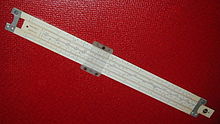
Back Rekenliniaal Afrikaans Rechenschieber ALS مسطرة حاسبة Arabic Regla de cálculu AST Loqarifmik xətkeş Azerbaijani Лагарыфмічная лінейка Byelorussian Сметачна линия Bulgarian Regle de càlcul Catalan Logaritmické pravítko Czech Llithriwl Welsh

A slide rule is a hand-operated mechanical calculator consisting of slidable rulers for evaluating mathematical operations such as multiplication, division, exponents, roots, logarithms, and trigonometry. It is one of the simplest analog computers.[1][2]
Slide rules exist in a diverse range of styles and generally appear in a linear, circular or cylindrical form. Slide rules manufactured for specialized fields such as aviation or finance typically feature additional scales that aid in specialized calculations particular to those fields. The slide rule is closely related to nomograms used for application-specific computations. Though similar in name and appearance to a standard ruler, the slide rule is not meant to be used for measuring length or drawing straight lines. Nor is it designed for addition or subtraction, which is usually performed using other methods, like using an abacus. Maximum accuracy for standard linear slide rules is about three decimal significant digits, while scientific notation is used to keep track of the order of magnitude of results.
English mathematician and clergyman Reverend William Oughtred and others developed the slide rule in the 17th century based on the emerging work on logarithms by John Napier. It made calculations faster and less error-prone than evaluating on paper. Before the advent of the scientific pocket calculator, it was the most commonly used calculation tool in science and engineering.[3] The slide rule's ease of use, ready availability, and low cost caused its use to continue to grow through the 1950s and 1960s, even as desktop electronic computers were gradually introduced. But after the handheld scientific calculator was introduced in 1972 and became inexpensive in the mid-1970s, slide rules became largely obsolete, so most suppliers departed the business.
In the United States, the slide rule is colloquially called a slipstick.[4][5]
- ^ Roger R. Flynn (June 2002). Computer sciences. Vol. 1. Macmillan. p. 175. ISBN 978-0-02-865567-3. Retrieved 2013-03-30.
The slide rule is an example of a mechanical analog computer...
- ^ Ernst Bleuler; Robert Ozias Haxby (2011-09-21). Electronic Methods. Academic Press. p. 638. ISBN 978-0-08-085975-0. Retrieved 2013-03-30.
For example, slide rules are mechanical analog computers
- ^ "Slide Rules". MIT Museum. Massachusetts Institute of Technology. Retrieved 2019-05-01.
- ^ Berrey, Lester V.; van den Bark, Melvin (1953). American Thesaurus of Slang: A Complete Reference Book of Colloquial Speech (2nd ed.). Crowell. OCLC 319462.
- ^ Petroski, Henry (2011). An Engineer's Alphabet: Gleanings from the Softer Side of a Profession. Cambridge University Press. pp. 46–47. ISBN 9781139505307. Retrieved 2017-03-21.